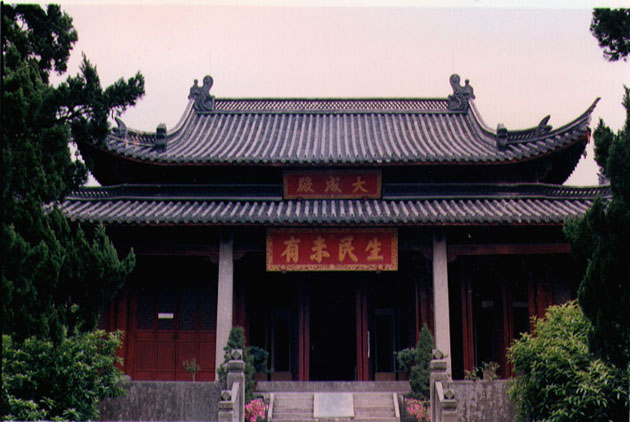

The temple at Quzhou
The word "Confucianism" is a sixteenth-century Jesuit conceit that purports to be a translation of a Chinese term. The most common Chinese term for what Westerners call Confucianism, however, is more felicitously rendered the "School of the Learned" (Ru jia). This educated Ru group may have emerged within lower echelons of the aristocracy as early as the Shang (1766-1027 B.C.), but it was apparently not understood as a distinctive school of thought until relatively late. The three most prominent figures of the early "School of the Learned" -- Confucius (Kongzi), Mencius (Mengzi), and Xunzi -- did not use it to name their tradition. They tended to speak, instead, of the "Way of the Gentleman," not so much as a name for a philosophical tradition than as a paragon of one who embodied virtue in his conduct. In one of the earliest histories of ancient Chinese philosophy, Sima Tan (d. 110 B.C.) names the "School of the Learned" (or Ru jia) among other competing philosophical schools in order to demonstrate that only the School of the Way and Potency (usually referred to as Daoism) can encompass the strengths of all schools. The division of the philosophical masters and their followers of the late Zhou into discrete schools gained greater currency in the Han when Sima Tan's essay appeared in the Historical Records, begun under his editorship and completed by his son, Sima Qian. Even in Liu Xiang's (77-6 B.C.) more "Confucian" essay summarizing seven schools of the late Zhou, one is struck by a concern that Kongzi's followers had splintered rather than unified this school. Liu distinguishes among 103 schools of Kongzi's followers, divided according to different exegetical traditions of the Confucian canon. Two other terms to refer to this school were coined in Sima Qian's Historical Records: the "forest of the learned" (ru lin), which became the standard term in most subsequent dynastic histories, and Ru Learning, which, along with Ru jia, is commonly used today to refer to Confucianism.
During much of the imperial era of Chinese history, the teachings and ritual practices of Confucianism occupied a privileged status in the education and training of the men who served in the civil bureaucracy. The precise ways in which the government expressed its preference for Confucianism over competing schools, and the extent to which the state actually adhered to Confucian doctrine, waxed and waned significantly during the course of the last two thousand years. Although Confucius enjoyed a certain prominence during his own lifetime, it was not until the Han (206 B.C.-A.D. 220) that rulers began to distinguish his teachings from those of other thinkers of the Zhou dynasty by canonizing Confucianism as an officially favored teaching. The canonization of Confucianism was a gradual and complex process that involved several different types of official acts and proclamations that were not always consistently applied. Perhaps the most signal act that effected this canonization was in 136 B.C., when the Han emperor Wu (r. 141-87 B.C.), acting on the advice of Dong Zhongshu (ca. 179-104 B.C.), eliminated all court positions of canonical scholars called Erudites who taught non-Confucian texts, in effect establishing Confucianism as the sole teaching of the imperial court. The court's privileging of the "Confucian canon" became a critical part of the establishment of Confucianism as orthodoxy in the Song (960-1279), with the emergence of the civil service examination system as the most important means of appointment to positions in the bureaucracy.
